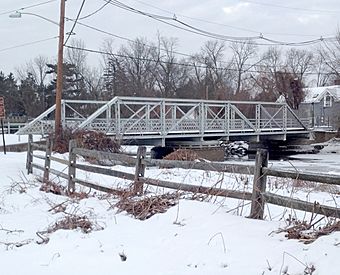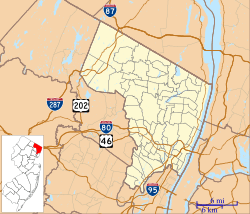Swing Bridge at New Bridge Landing facts for kids
|
Draw Bridge at New Bridge
|
|
 |
|
| Location | Main Street and Old New Bridge Road over the Hackensack River, New Milford, New Jersey |
|---|---|
| Area | 0.4 acres (0.16 ha) |
| Built | 1888 |
| Architect | Stagg, Joseph W.; King Bridge Company |
| Architectural style | Pratt-type low truss bridge |
| NRHP reference No. | 89000775 |
Quick facts for kids Significant dates |
|
| Added to NRHP | July 5, 1989 |
The Draw Bridge at New Bridge is a special bridge in New Jersey. It was built in 1888. This bridge replaced an older wooden one. It is very old and important. Because of its history, it was added to the National Register of Historic Places on July 5, 1989. This means it's officially recognized as a historic site.
Contents
The Bridge's Long History
The current iron bridge stands where many wooden bridges once were. Bridges have crossed the Hackensack River at New Bridge since 1745. Before 1790, this was the first river crossing above Newark Bay. It was a key route for travel between Manhattan and other parts of North America.
A Vital Role in the American Revolution
This bridge became super important during the American Revolution. On November 20, 1776, General George Washington crossed it. He was leading his soldiers from Fort Lee during a retreat. This event gave the bridge its nickname: "The Bridge That Saved A Nation."
Hills on both sides of New Bridge were fortified during the war. These defenses protected this important crossing. Stone houses near the bridge were used as forts and military headquarters. New Bridge was truly a "crossroads of the American Revolution." It is said to have seen more of the war than almost any other place in America.
Building the Iron Swing Bridge
In 1889, Bergen County installed the iron swing bridge we see today. This was part of a plan to replace old wooden drawbridges. Wooden drawbridges were slow because they only opened one lane for boats. A swing bridge, however, could open two lanes. This allowed boats to pass in both directions at the same time.
In April 1888, the county decided to build a new bridge. They wanted to span the Hackensack River at New Bridge village. The estimated cost for the new bridge was about $9,000. After reviewing plans, contracts were given out in July 1888. The King Bridge Company won the contract to build the iron parts. Joseph W. Stagg won the contract for the stone work.
Joseph Stagg started taking down the old bridge in August 1888. He also began laying the stone for the new bridge's supports. By November 1888, people were getting impatient. The old bridge was gone, but the new iron parts had not arrived. A fire at the King Bridge Company's factory caused delays.
The new iron swing bridge finally opened on Monday, February 4, 1889. Joseph Stagg was paid for building a temporary foot-bridge. This temporary bridge helped people cross the river while they waited for the new iron bridge. In March 1889, the roads leading to the new bridge were completed.
In June 1891, people were hired to operate the bridge. They were called bridge-keepers. In 1900, a wooden sidewalk was added to the north side of the bridge.
Bridge Challenges and Changes
On November 14, 1906, a train accident caused delays near the bridge. On the same night, the New Bridge got stuck open after a boat passed. This caused even more delays for travelers.
The bridge continued to be used, mainly for coal and lumber boats. But in 1940, a new fixed bridge was built downstream. This new bridge meant that larger boats could no longer travel upstream to New Bridge.
In 1956, a new road and a new concrete-and-steel bridge were built. This new bridge was about 500 feet north of the old iron bridge. This new construction helped protect the historic Steuben House nearby. After the new bridge was built, the 1889 swing bridge was closed to cars. This made Main Street in River Edge and Old New Bridge Road into dead ends.
Saving a Historic Landmark
The Army Corps of Engineers initially planned to destroy the old bridge. But the Bergen County Historical Society and the Dumont Women's Club stepped in. They successfully asked to keep the historic bridge for people to walk across. The county promised to take care of the old bridge if it was saved.
Historians Claire Tholl and Kevin Wright did research on the bridge. Their work helped it get listed on the New Jersey and National Registers of Historic Places in 1989. This happened to celebrate its 100th birthday. Today, it is known as the oldest surviving highway swing-bridge in New Jersey. It can no longer swing open because it has been welded in place.
In October 2003, the bridge was repaired and restored. This work was approved by the Historic New Bridge Landing Park Commission.


